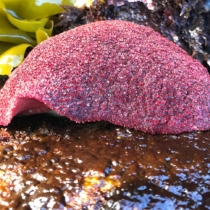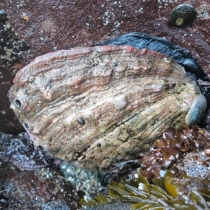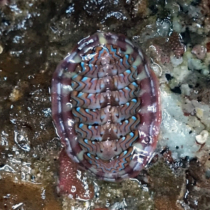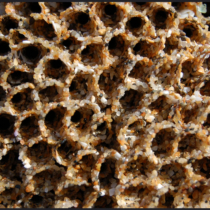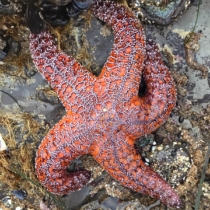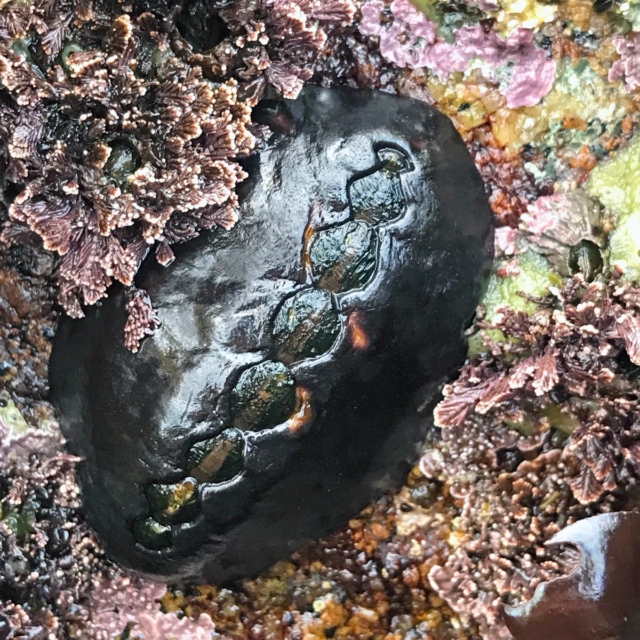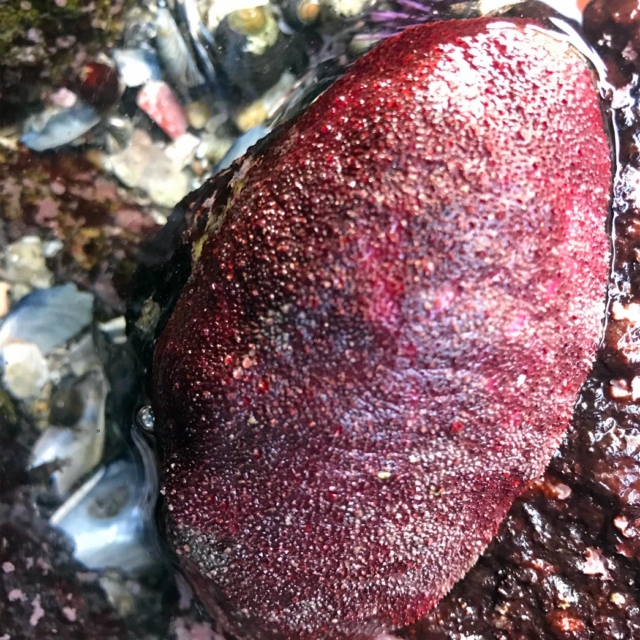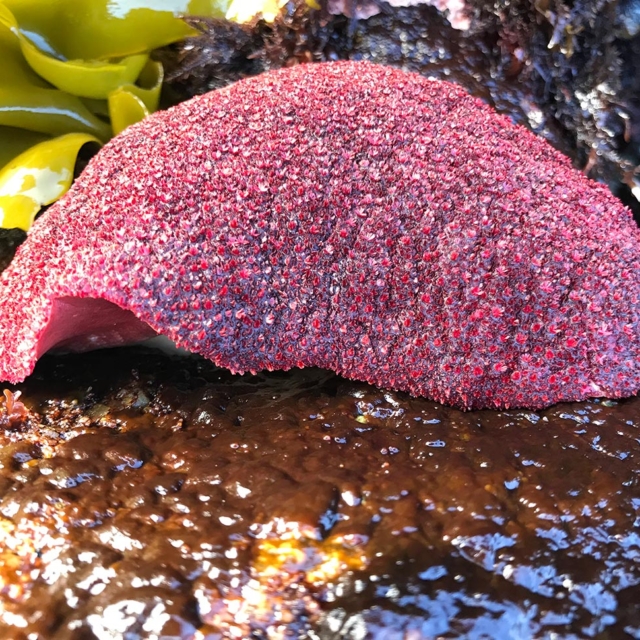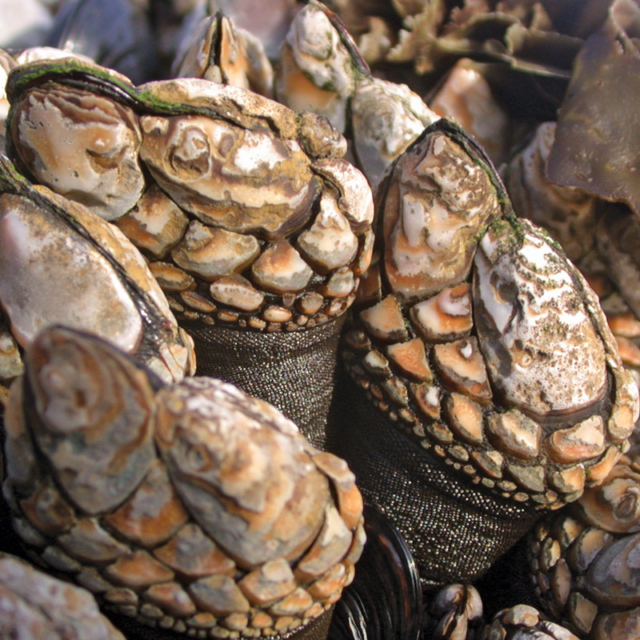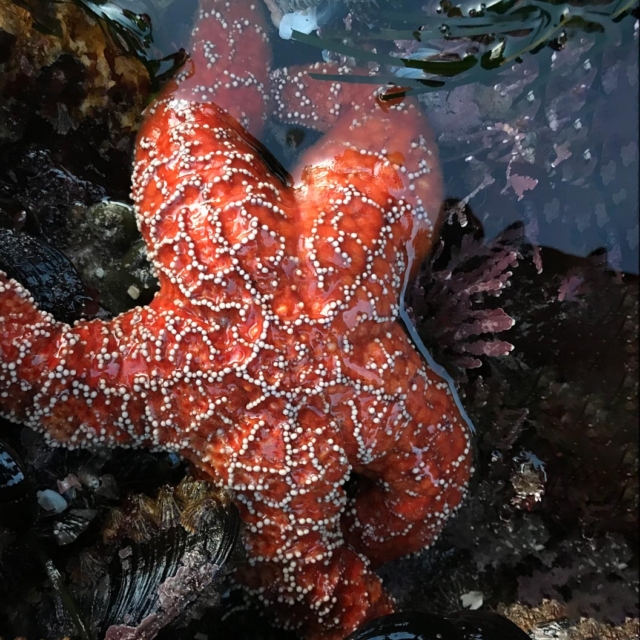There are 27 groups of algae and invertebrates targeted for this program. Each taxon or species was selected for one or more of the following reasons:
- it is common and abundant at LiMPETS sites;
- it is near the edge of its northern or southern distribution limits (e.g., sunburst anemones and pink acorn barnacles);
- it is a major space competitor, predator, or herbivore (e.g., ochre sea stars and owl limpets);
- it is sensitive to trampling, harvesting, or pollution (e.g., owl limpets, flattened rockweed, and surfgrass);
- it is easy to recognize or to quantify in the field;
- it is fun to monitor and catches the interest of those persons with short attention spans.
LiMPETS follows the taxonomy of the World Register of Marine Species (WoRMS).
Algae
Identifying algae is not always easy! Learn more about the algae monitored by the LiMPETS program. The list below consists of taxa that are monitored at all our sites.
- Coralline Algae
- Green Pin Cushion Alga
- Iridescent Algae
- Rockweeds
- Scouring Pad Alga
- Sea Lettuces
- Stunted Turkish Towel
- Surfgrasses
- Tar Spot Algae

Coralline Algae (Bossiella spp./ Calliarthron spp./Corallina spp. / many species)
- Description
Coralline algae comes in two forms: encrusting and upright.
There are many types of encrusting coralline algae, at least five genera and nine species are found along our coast. Species can be difficult to correctly identify in the field; their distinguishing characteristics are traits such as crust thickness, cell dimensions, and reproductive structures. All of the species are “crunchy” due to the calcium carbonate found in their cell walls. They range in color from grey to dull pink to bright pink.
Many species, often difficult to distinguish from one another. All of the species have calcium carbonate deposits in their cell walls, making them relatively stiff; many species are branched and have tiny jointed segments. Sometimes they persist without upright segments, in which case they are counted as Encrusting Coralline Algae. They are found in a variety of colors including grey, dull pink and bright pink.
- Distribution
- Alaska to Chile.
- Habitat
- Abundant on rocks and mollusk shells in the mid to low rocky intertidal and shallow subtidal; on rock faces and in tidepools.
- Diet
- Calcium and magnesium carbonate from the seawater as well as sunlight and dissolved nutrients, which are required for photosynthesis.
- Fun Fact
It used to be thought that encrusting corallines were animals related to coral. In the tropics, they have an important role in building coral reefs.
Although the calcium carbonate in the tissues make it difficult for many animals to feed on these algae, there are a few molluscs, like lined chitons and dunce-cap limpets, that readily feed on them.
- Reason for Monitoring
These algae are resistant to trampling and pollution, though sensitive to dessication (drying out due to air exposure). They are a dominant species on primary substrate.
Resistant to grazing, trampling, and pollution, especially Corallina spp., which sometimes are the main algae remaining around sewage discharges.
- References
Mondragon, J and J. Mondragon. 2003. Seaweeds of the Pacific Coast: Common Marine Algae from Alaska to Baja California. Sea Challengers, Monterey,California.
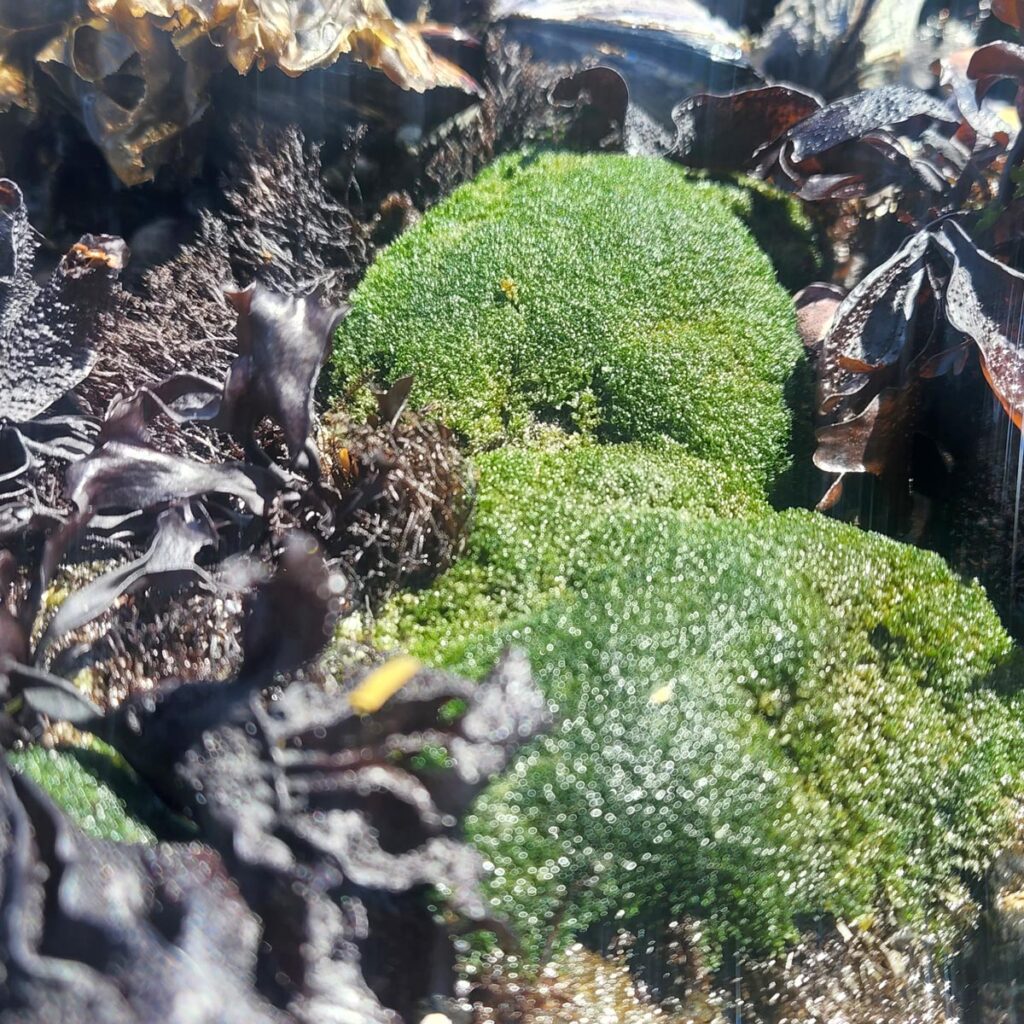
Green Pin Cushion Alga (Cladophora columbiana)
- Description
Green pin-cushion alga is bright green, spongy, and consists of branched filaments that form densely matted tufts. It resembles clumps of moss. This alga effectively holds water and can withstand long periods of exposure.
- Distribution
- British Columbia to Baja California.
- Habitat
- Common, on rocks, in the mid to high intertidal.
- Diet
- Sunlight and dissolved nutrients, which are required for photosynthesis.
- Fun Fact
Competition for space in the intertidal is a factor for all organisms. This alga not only competes with other algae, it also competes for space with several marine invertebrates. In some cases, the seaweed effectively smothers sessile invertebrates such as mussels and barnacles by growing on top of them.
- Reason for Monitoring
It is a high intertidal zone indicator.
- References
Mondragon, J and J. Mondragon. 2003. Seaweeds of the Pacific Coast: Common Marine Algae from Alaska to Baja California. Sea Challengers, Monterey,California.

Iridescent Algae (Mazzaella flaccida/splendens)
- Description
These algae are seen in a variety of colors including dark-purple, brown, green, bluish-purple, and may even appear black. They appear iridescent when underwater or when wet because of thin layer interference. The blades are relatively thin and vary in shape and size (up to 3 feet long and 10 inches wide) depending on the habitat and the amount of wave exposure.
- Distribution
- Alaska to northern Baja California.
- Habitat
- Abundant on rocks in the mid to low intertidal and upper subtidal. Found in both exposed and moderately sheltered habitats.
- Diet
- Sunlight and dissolved nutrients, which are required for photosynthesis.
- Fun Fact
Iridescent algae are one source for carrageenan, a substance commonly used to thicken, stabilize or jell products such as toothpaste, ice cream and cosmetics.
- Reason for Monitoring
They are a mid zone indicator, dominant competitor, and are potentially harvested for carrageenan.
- References
Mondragon, J and J. Mondragon. 2003. Seaweeds of the Pacific Coast: Common Marine Algae from Alaska to Baja California. Sea Challengers, Monterey, California.
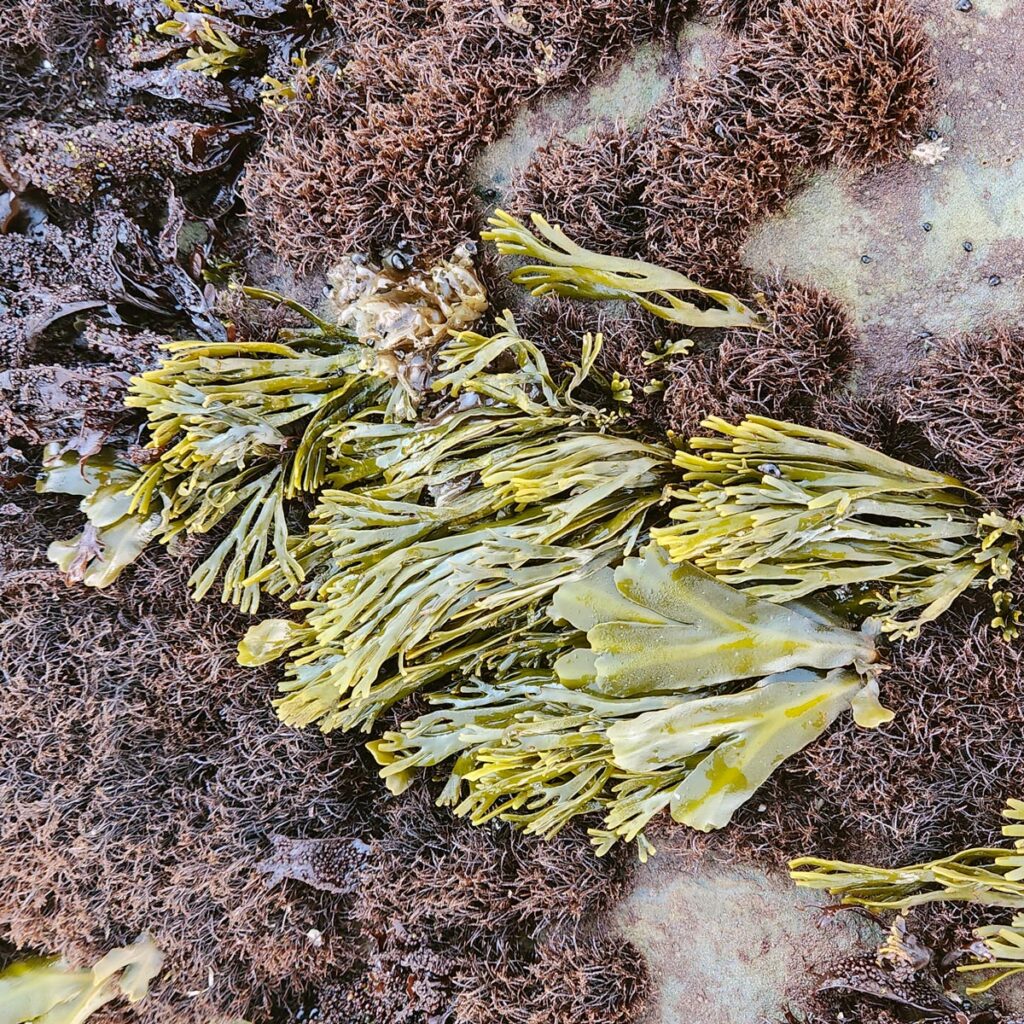
Rockweeds (Fucus gardneri / Hesperophycus californicus / Pelvetiopsis limitata / Silvetia compressa)
- Description
Olive green to brownish in color. They can reach 25-30 cm (1 foot) in length; have a small holdfast and flattened, dichotomously branched blades with a distinct midrib. The holdfast is leathery, conical, and relatively small. Mature branches will have swollen, warty receptacles at the tips. Some rockweeds have a thick outside layer that makes a sticky substance to help retain moisture.
- Distribution
- British Columbia to central Baja California.
- Habitat
- Common in the high to mid intertidal zone.
- Diet
- Sunlight and dissolved nutrients, which are required for photosynthesis.
- Fun Fact
To discourage predation, rockweeds secrete a chemical that makes them hard to digest.
These algae are frequently exposed to air at low tide, and can photosynthesize both in and out of water. The fronds trap moisture and provide protection to barnacles, shore crabs, tubeworms and snails.
- Reason for Monitoring
Sensitive to trampling; a high zone indicator.
- References
Mondragon, J and J. Mondragon. 2003. Seaweeds of the Pacific Coast: Common Marine Algae from Alaska to Baja California. Sea Challengers, Monterey,California.
UCSC’s Pacific Rocky Intertidal Netowrk: Herperophycus (Olive rockweed)
UCSC’s Pacific Rocky Intertidal Monitoring: Pelvetiopsis (Dwarf Rockweed)
UCSC’s Pacific Rocky Intertidal Monitoring: Silvetia (Golden Rockweed)

Scouring Pad Alga (Endocladia muricata)
- Description
This is dense, bushy, stiff, profusely branched, and spine-covered algae. It forms dark-brown to reddish-brown clumps that grow to be 3-8 cm tall. For LiMPETS monitoring purposes, it is crucial to note that an extremely similar species,Caulacanthus ustulatus, can be confused with the native scouring pad alga, E. muricata. The best way to distinguish between the two species is to pinch off a piece and look at the axes: E. muricata has small spines along its axis and C. ustulatus does not. The axes of C. ustulatus are round and the tips are pointed. In addition, E. muricata is a dark red/brown color, while C. ustulatus is a lighter red. Learn to distinguish between these two species, before going into the field. C. ustulatus is a non-native, potentially invasive species that has the potential to displace E. muricata.
- Distribution
- Alaska to Baja California.
- Habitat
- Abundant in the high intertidal on tops or vertical faces of rocks and on mussels. The highly branched, bushy nature of this alga and the clumps that it forms enable it to retain moisture during low tide; allowing it to survive in the high intertidal.
- Diet
- Sunlight and dissolved nutrients, which are required for photosynthesis.
- Fun Fact
This alga serves as a refuge for more than 90 species of animals, including snails, worms, mussel, and fly larvae and is usually found in association with small acorn barnacles, Balanus glandula and Chthamalus spp.; other common inhabitants of the high intertidal.
- Reason for Monitoring
Sensitive to trampling and is a high and upper mid zone indicator.
- References
Mondragon, J and J. Mondragon. 2003. Seaweeds of the Pacific Coast: Common Marine Algae from Alaska to Baja California. Sea Challengers, Monterey, California.
UCSC’s Pacific Rocky Intertidal Monitoring: Endocladia (Turfweed)

Sea Lettuces (Ulva spp.)
- Description
Sea lettuces are bright green, thin, tubular to broad, and often crumpled-looking algae. They are only two cells thick and almost transparent. They attach to rocks with a small holdfast, and can easily be torn away. Sea lettuces can form large blooms when nutrient levels are high and then bleach and die. Tubular forms,Enteromorpha spp., are now included among the species of Ulva.
- Distribution
- Worldwide; along the West Coast of North America, from Alaska to Mexico.
- Habitat
- Common in bays, lagoons, harbors, marshes, and open rocky coast; found in the intertidal and shallow subtidal.
- Diet
- Sunlight and dissolved nutrients, which are required for photosynthesis.
- Fun Fact
These algae are commonly eaten; they are dried, toasted or eaten fresh in salads, soups and other dishes. Many species of Ulva are reported to be tolerant of organic and metal pollution; so if you eat these algae, make sure they are collected far from any potential sources of pollution.
- Reason for Monitoring
Indicates high disturbance areas. After a disturbance, they are among the first algae to grow back and populate an area, before being grazed and replaced by other algae.
- References
Mondragon, J and J. Mondragon. 2003. Seaweeds of the Pacific Coast: Common Marine Algae from Alaska to Baja California. Sea Challengers, Monterey, California.

Stunted Turkish Towel (Mastocarpus spp./Mazzaella affinis)
- Description
These are common algae in the California intertidal. The two species of Mastocarpus, M. papillatus and M. jardinii, as well as Mazzaella affinis, are difficult to distinguish and are put in one category for monitoring. All three have small dark red to purplish-black blades that split near their ends; the blades can be narrow (1-2 cm) or wide (5-7 cm). The blades of both species of Mastocarpus often are covered with bumps (papillae); they have a complex life cycle with a crust phase that looks very different from the often bumpy blades of the upright phase. The crust phase is monitored separately as some of the many species of tar-spot algae.
- Distribution
- Alaska to Baja California.
- Habitat
- Abundant in mid to high rocky intertidal areas.
- Diet
- Sunlight and dissolved nutrients, which are required for photosynthesis.
- Fun Fact
Before the life cycle was understood, phycologists thought that the crust phase of Mastocarpus spp. was a distinct species that was placed in a separate genus, Petrocelis.
- Reason for Monitoring
They are common and abundant species in the high and mid zones of many of the LiMPETS sites, and are sensitive to trampling.
- References
Mondragon, J and J. Mondragon. 2003. Seaweeds of the Pacific Coast: Common Marine Algae from Alaska to Baja California. Sea Challengers, Monterey, California.

Surfgrasses (Phyllospadix scouleri/torreyi)
- Description
Surfgrasses are flowering plants, grassy green to bright green in color. The leaves are narrow (1-4 mm) and can be up to 2 m in length depending on the species. They provide an important habitat for algae and marine invertebrates.
- Distribution
- Alaska to Baja California.
- Habitat
- Usually found in the low intertidal and subtidally to 6m. Some species of surfgrass are usually found in protected sandy areas (P. torreyi), while others such as P. scouleri are usually attached to rocks in exposed areas. However, the two species can be extensively intermingled.
- Diet
- Sunlight and dissolved nutrients, which are required for photosynthesis.
- Fun Fact
Native Americans along the West Coast harvested the seeds of surfgrasses for food. The seeds are high in caloric value and in protein.
- Reason for Monitoring
Surfgrasses are a competitive dominant marking the upper limit of the low zone and are sensitive to pollution.
- References
Mondragon, J and J. Mondragon. 2003. Seaweeds of the Pacific Coast: Common Marine Algae from Alaska to Baja California. Sea Challengers, Monterey,California.
UCSC’s Pacific Rocky Intertidal Monitoring: Phyllospadix (Surfgrass)

Tar Spot Algae (Mastocarpus spp./Ralfsia spp. and others)
- Description
These algae are dark brown to black crusts that grow on rocks. They are smooth or have prominent radial and concentric ridges. There are many nearly indistinguishable crust forms of several species of red and brown algae. Species of Ralfsia (brown algae) are nearly indistinguishable from the sporophyte crust of Mastocarpus spp. (red algae), so they are counted together, along with other less abundant species of encrusting red and brown algae, as tar spot algae for the purpose of LiMPETS monitoring.
- Distribution
- Alaska to Mexico.
- Habitat
- Common on rocks throughout the intertidal.
- Diet
- Sunlight and dissolved nutrients, which are required for photosynthesis.
- Fun Fact
At least one “species” of Ralfsia is a growth form of an upright, thin blade-like brown algal species, Petalonia fascia. Whether it is a crust or blade may depend on temperature and photoperiod; warm temperature and long day lengths lead to the crust form. On the other hand, the tar-spot forms of Mastocarpus spp. are separate parts of the life cycle of those species, which are monitored as Stunted Turkish Towel algae by LiMPETS.
- Reason for Monitoring
These encrusting forms are resistant to grazing, trampling, and pollution and can be the dominant species on primary substrate.
- References
Monterey Bay Aquarium Research Institute: Marine Botany
Abbott, I.A. and G.J. Hollenberg. 1976. Marine Algae of California. Stanford, University Press, Stanford, California.
We also monitor:
- Bare rock
- Loose sand
- Tar (petroleum)
Invertebrates
Learn more about the invertebrates monitored by the LiMPETS program. The list below includes our core taxa (monitored at all sites) and regional taxa (monitored at only one or two sites).
- Aggregating Anemone
- Black Abalone
- Chitons
- Common Acorn Barnacles
- Giant Green Anemone
- Hermit Crabs
- Honeycomb Tube Worm
- Leaf Barnacle
- Limpets
- Ochre Sea Star
- Owl Limpet
- Pink Acorn Barnacle
- Purple Sea Urchin
- Sea Mussel
- Sunburst Anemone
- Turban Snails
- Whelks
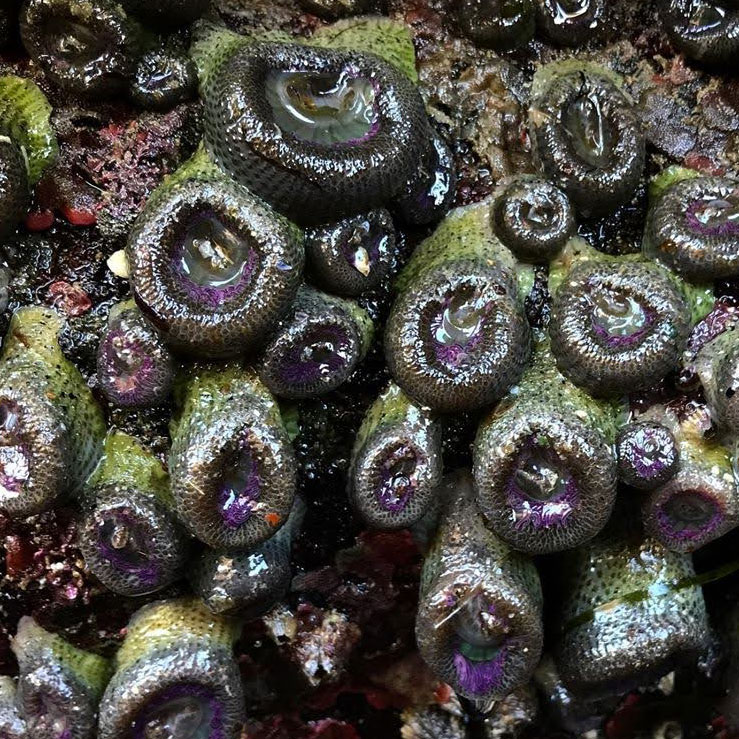
Aggregating Anemone (Anthopleura elegantissima)
- Description
Small (2-5 cm) greenish-colored body, often with pink-tipped tentacles; large rounded tubercles arranged in vertical rows on column, often covered in sand and shells; radiating lines in oral disc; can form dense aggregations.
- Distribution
- Alaska to Baja California.
- Habitat
- Semiprotected rocky shores of bays and rocky coasts; abundant on rocks, in crevices or in tidepools in mid zone.
- Diet
- Predator, eating copepods, isopods, amphipods, and other small animals that come in contact with the tentacles. Also possess symbiotic algae within their tissues that provide supplimental nourishment and oxygen.
- Fun Fact
These anemones can reproduce asexually or sexually; asexually by producing clones of themselves by longitudinal fission. All individuals in a group are members of a single clone, and are genetically identical to one another. Each clone is either male or female and all members produce either sperm or eggs.
- Reason for Monitoring
Aggregating anemones are a major space occupier that competes with algae, mussels, and honeycomb tubeworms.
- References
Morris, R.H., D.P. Abbott, and E.C. Haderlie. 1980. Intertidal Invertebrates of California. Stanford University Press, Stanford, California.

Black Abalone (Haliotis cracherodii)
- Description
The low, shield-like, smooth shell of this abalone is dark blue, dark green, or almost black in color. Shell can reach lengths of 20 cm or more and contains a line of holes used for ventilation. Tentacles are black.
- Distribution
- Mendocino County, California to Baja California; rare north of San Francisco.
- Habitat
- Common under rocks and in crevices, from the high intertidal to 6 meters deep. This species occurs higher in the intertidal than any other California abalone.
- Diet
- Herbivore, eating diatoms films, coralline algae, and loose pieces of algae brought in by waves.
- Fun Fact
Natural predators of the abalone include octopuses, whelks, sea stars, fish, sea otters, and humans.
- Reason for Monitoring
Abalone populations once occurred at a density of 60 to 80 individuals per square meter and dominated the intertidal in southern California. This species has experienced population decline due to overfishing, poaching, and disease (i.e., withering syndrome) throughout its range and has gone locally extinct in most locations south of Point Conception.
- References
Morris, R.H., D.P. Abbott, and E.C. Haderlie. 1980. Intertidal Invertebrates of California. Stanford University Press, Stanford, California.
UCSC’s Pacific Coast Rocky Intertidal Monitoring: Haliotis cracherodii (Black Abalone)
For more information visit the NOAA Fisheries Species Directory for Black Abalone
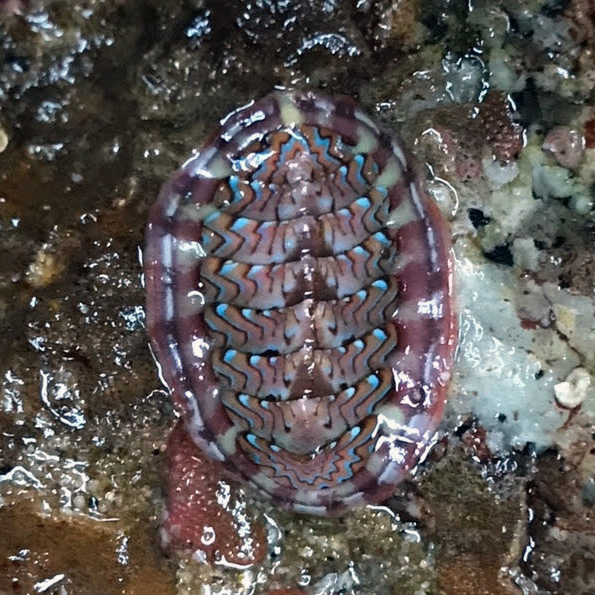
Chitons (Mopalia spp./ Nuttallina spp./ Tonicella spp./others)
- Description
Chitons are a basal group of mollusks. They are oval in shape and have 8 separate, overlapping calcareous plates. The plates are embedded in a tough muscular girdle. They can be many different colors and can be easily overlooked because they are often small and well camouflaged.
- Distribution
- Alaska to Baja California.
- Habitat
- Fairly common on intertidal rocky shores; many are nocturnal and remain hidden under rocks in the daytime.
- Diet
- Chitons scrape algal films off the rocks with their radula; also feed on other algae such as stunted Turkish towel, scouring pad alga, coralline algae, and green-pin cushion alga.
- Fun Fact
Like snails and limpets, chitons have a long tongue-like radula used for feeding. The radula has rows of strong, iron-capped teeth that scrape algae off of the rocks. Although they have no real “head” they have many tiny eyes in their shells.
- Reason for Monitoring
Important grazers of algae in the intertidal.
- References
Morris, R.H., D.P. Abbott, and E.C. Haderlie. 1980. Intertidal Invertebrates of California. Stanford University Press, Stanford, California.

Common Acorn Barnacles (Balanus glandula/ Chthamalus dalli/fissus)
- Description
Balanus glandula is moderate in size (~2 cm), white with a diamond-shaped operculum and more heavily ribbed walls. Chthamalus dalli/fissus is smaller (<1 cm), brownish with an oval shaped operculum, and smoother walls.
- Distribution
- Alaska to Baja California. Balanus glandula has been introduced to the shores of Argentina in the past 30 years, and has become an invasive species there.
- Habitat
- Found along the open coast and in bays. Balanus glandula is common in mid to low intertidal on mussels and rocks. Chthamalus dalli/fissus is common in the high to mid intertidal.
- Diet
- Plankton. Barnacles filter plankton from the water using their feathery, segmented legs.
- Fun Fact
As adults, barnacles are hermaphrodites. They fertilize one another internally by means of a long penis. The eggs are brooded by the parent and released as nauplius larvae.
- Reason for Monitoring
Competitors for space in the high and mid zone. Major prey for many intertidal species. Susceptible to high mortality from oil spills because oil can stick to high intertidal habitat.
- References
Morris, R.H., D.P. Abbott, and E.C. Haderlie. 1980. Intertidal Invertebrates of California. Stanford University Press, Stanford, California.
UCSC’s Pacific Rocky Intertidal Monitoring: Chthamalus/Balanus (Acorn Barnalces)

Giant Green Anemone (Anthopleura xanthogrammica)
- Description
Large, solitary anemone up to 25 cm in diameter (10 inches), same size as sunburst anemone or larger; olive-green to bluish green disc without radiating lines; small irregular tubercles arranged haphazardly on column gives this beautiful creature a velvet-like texture.
- Distribution
- Alaska to northern Baja California.
- Habitat
- Usually in pools within or below mussel beds, low intertidal to subtidal; found on exposed rocky shores, in open bays and harbors.
- Diet
- Mainly detached mussels, crabs, sea urchins and small fishes. Also possess symbiotic algae within their tissues that provide supplimental nourishment and oxygen. The striking bluish-green color is caused by pigments produced by the animals themselves, not the algae, which in California are golden brown in color (farther north some specimens have grass-green algae in their tissues).
- Fun Fact
Stinging cells called cnidocytes are located within the tentacles of all anemones. These cells help the anemone to paralyze its prey; however, stinging cells of California anemones do not harm humans when touched, but those of some tropical species cause painful stings.
- Reason for Monitoring
This is a northern species. Though it occurs from Alaska to northern Baja California, it is restricted to upwelling areas in the southern part of its range. Distribution of this species may shift farther north if global warming continues. Major space competitor and predator, associated with mussels.
- References
Morris, R.H., D.P. Abbott, and E.C. Haderlie. 1980. Intertidal Invertebrates of California. Stanford University Press, Stanford, California.

Hermit Crabs (Pagurus spp.)
- Description
Rocky intertidal hermit crabs in California are represented by the family Paguridae. They live in the abandoned shells of snails to protect their soft abdomens. Carapace grows to approximately 2 cm in length. P. hirsutiusculus, abundant in the mid zone, has white bands on walking legs, dark antennae with fine white bands, and a dark orange-brown body. P. samuelis is the most abundant hermit crab in the high zone of central and southern California. It has a hairy carapace and legs, blue bands on walking legs, and red antennae.
- Distribution
- Varies with species.
- Habitat
- Common in tidepools on rocky shores; P. hirsutiusculus is usually found in the mid to low intertidal; P. samuelis is typically found in the high to mid intertidal but also subtidally in giant kelp holdfasts.
- Diet
- Important scavengers of dead plant and animal matter.
- Fun Fact
Hermit crabs can be choosey about the shells they live in.
P. hirsutiusculus prefers the shells of olive snails while P. samuelisprefers the shells of turban snails.- Reason for Monitoring
Important scavengers of dead plant and animal matter. Sensitive to pollution. Fun to count.
- References
Morris, R.H., D.P. Abbott, and E.C. Haderlie. 1980. Intertidal Invertebrates of California. Stanford University Press, Stanford, California.

Honeycomb Tube Worm (Phragmatopoma californica)
- Description
These marine solitary, polychaete worms form large aggregations of cemented sand-grain tubes. Tubes form masses up to 2 m in length and are positioned in a honeycomb arrangement, each tube with a flared rim. Though the group of tubes looks like a colony, each tube is the result of one individual worm settling near other worms and building its home. These worms are up to 5 cm in length and bear a crown of lavender tentacles.
- Distribution
- Range from central California to Ensenada, Baja California.
- Habitat
- Common in mid to low intertidal; often overgrowing mussels, barnacles, and algae; solitary tubes meander on rocks in high mid zone.
- Diet
- Plankton and detritus.
- Fun Fact
This worms captures sand with its tentacles and transports the grains to an organ behind the mouth. Liquid cement is added to the sand for the construction of the walls of its tube.
- Reason for Monitoring
Major space competitor, mid zone indicator.
- References
Morris, R.H., D.P. Abbott, and E.C. Haderlie. 1980. Intertidal Invertebrates of California. Stanford University Press, Stanford, California.

Leaf Barnacle (Pollicipes polymerus)
- Description
Barnacle on dark, fleshy stalk; up to 8 cm in length; the top is covered with more than 5 white plates and surrounded by scales.
- Distribution
- British Columbia to Baja California.
- Habitat
- Form aggregations on rocks and among mussels; mid intertidal zone on wave-exposed rocky shores.
- Diet
- Filter feeds on particles of dead, decaying plants and animals in the backwash of waves. They often orient themselves to face the current and are therefore mostly seen facing the same direction.
- Fun Fact
These barnacles are a main food source for Glaucous-winged Gulls. In Europe, humans harvest and eat another species of leaf barnacles.
- Reason for Monitoring
Mid zone indicator; major space competitor with mussels.
- References
Morris, R.H., D.P. Abbott, and E.C. Haderlie. 1980. Intertidal Invertebrates of California. Stanford University Press, Stanford, California.
UCSC’s Pacific Rocky Intertidal Monitoring: Pollicipes (Goose Barnacle)

Limpets (Lottia spp.)
- Description
Limpets are a group of gastropod mollusks with one uncoiled cone-shaped or flattened shell. Their muscular foot helps them cling to rocks. There are a handful ofLottia species that inhabit the rocky intertidal of California: the shield limpet (L. pelta), ribbed limpet (L. austrodigitalis/digitalis), rough limpet (L. scabra), file limpet (L. limatula), owl limpet (L. gigantea), and others. These limpets range from 12 mm to 10 cm in size. Shell color varies, though most are brownish and mottled and are well camouflaged.
- Distribution
- Varies by species. The Family Lottidae has worldwide distribution, although the greatest diversity is on the west coast of North America.
- Habitat
- Most live intertidally, although some live on sea grasses and kelps. Many are common on vertical rock faces in the high intertidal and splash zone.
- Diet
- Important grazers of algae, especially microscopic films of algae and diatoms, on rocky surfaces.
- Fun Fact
Limpets often remain motionless during low tide during the day, but move about and forage at night, mainly during low tide. Some limpets will return after grazing to their own unique resting spot on the rock known as a “home site.” On soft rock, they chew out a depression in which their shells just fit, but on hard rock their shell grows to fit the rock.
- Reason for Monitoring
Major grazers and prey for shorebirds.
- References
Morris, R.H., D.P. Abbott, and E.C. Haderlie. 1980. Intertidal Invertebrates of California. Stanford University Press, Stanford, California.
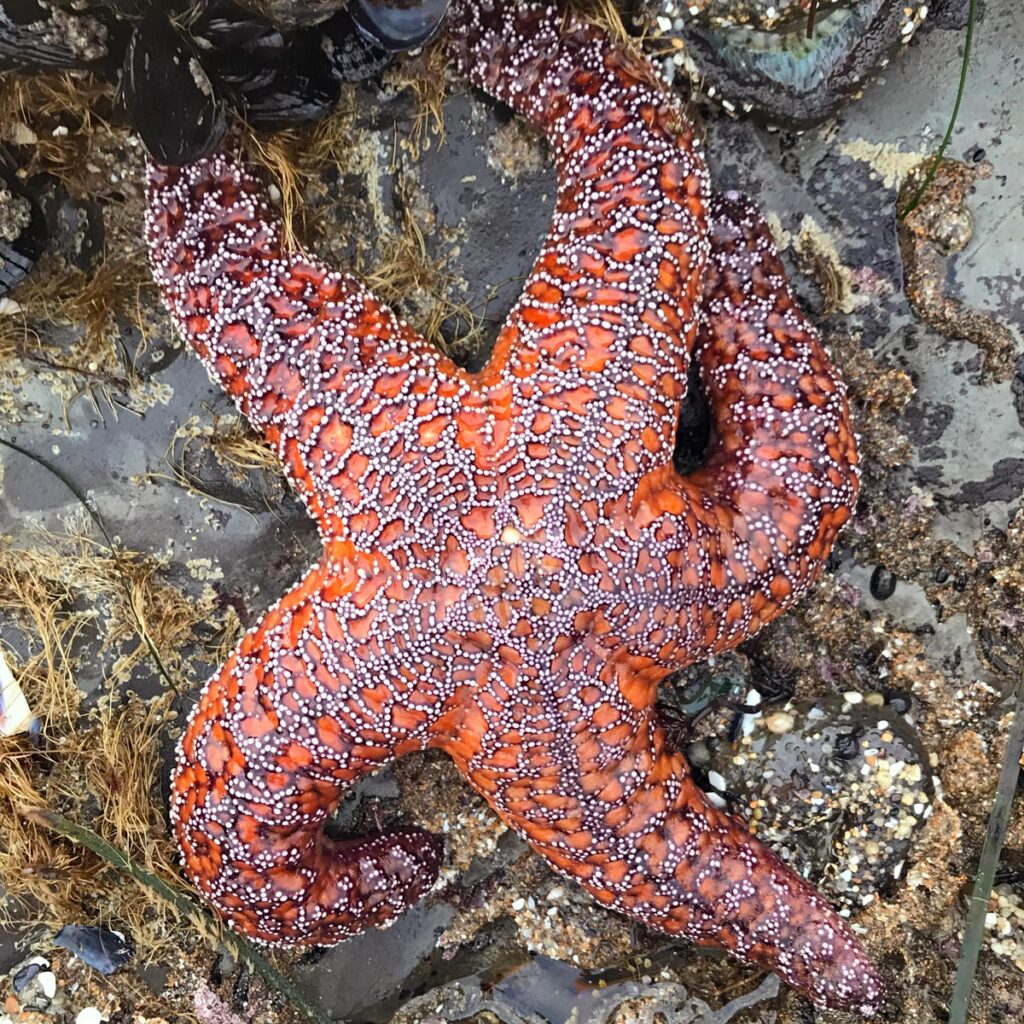
Ochre Sea Star (Pisaster ochraceus)
- Description
Sea star typically has 5 arms, but rarely has from 4-7; aboral surface with many small white spines; average length is 14 cm; color yellow/orange or deep brown/purple.
- Distribution
- Range Alaska to Santa Barbara, CA.
- Habitat
- Common in the middle and low intertidal; juveniles found in crevices and under rocks.
- Diet
- These sea stars can evert their stomachs and insert them into prey such as mussels, barnacles and snails.
- Fun Fact
Some prey can detect a scent from the ochre star and move away from the predator. This star has few predators including sea otters, gulls, and humans (for ornaments).
- Reason for Monitoring
Important predators, vulnerable to parasitic castration, and overcollecting by humans.
- References
Morris, R.H., D.P. Abbott, and E.C. Haderlie. 1980. Intertidal Invertebrates of California. Stanford University Press, Stanford, California.

Owl Limpet (Lottia gigantea)
- Description
This is the largest limpet in North America, reaching sizes up to 8 cm (3.5 inches) in length. The shell is oval and low in profile with the apex (highest point of the shell) positioned far forward. Shell surface often rough with raised brown areas relative to white areas. Tentacles and side of foot gray.
- Distribution
- Neah Bay, Washington to Baja California.
- Habitat
- Found in the mid to high zone, on cliff faces and rocks of wave-exposed shores.
- Diet
- Grazes algal films off rocks with a hard radula.
- Fun Fact
Owl limpets are hermaphrodites. They are born males and become females as they grow older and larger. The females have distinct grazing territories or “farms” that they clear by scraping rocks free of algae. This action creates space and promotes algal growth. Females are territorial and will dislodge small mussels, limpets and anemones from their territories by bulldozing them off the rock with the edge of their shell.
- Reason for Monitoring
Humans eat owl limpets and preferentially take the largest limpets in a population for consumption. As a result, populations may become dominated by smaller males, skewing the gender ratio and decreasing reproduction.
- References
Morris, R.H., D.P. Abbott, and E.C. Haderlie. 1980. Intertidal Invertebrates of California. Stanford University Press, Stanford, California.
UCSC’s Pacific Rocky Intertidal Monitoring: Lottia gigantea (Owl Limpet)
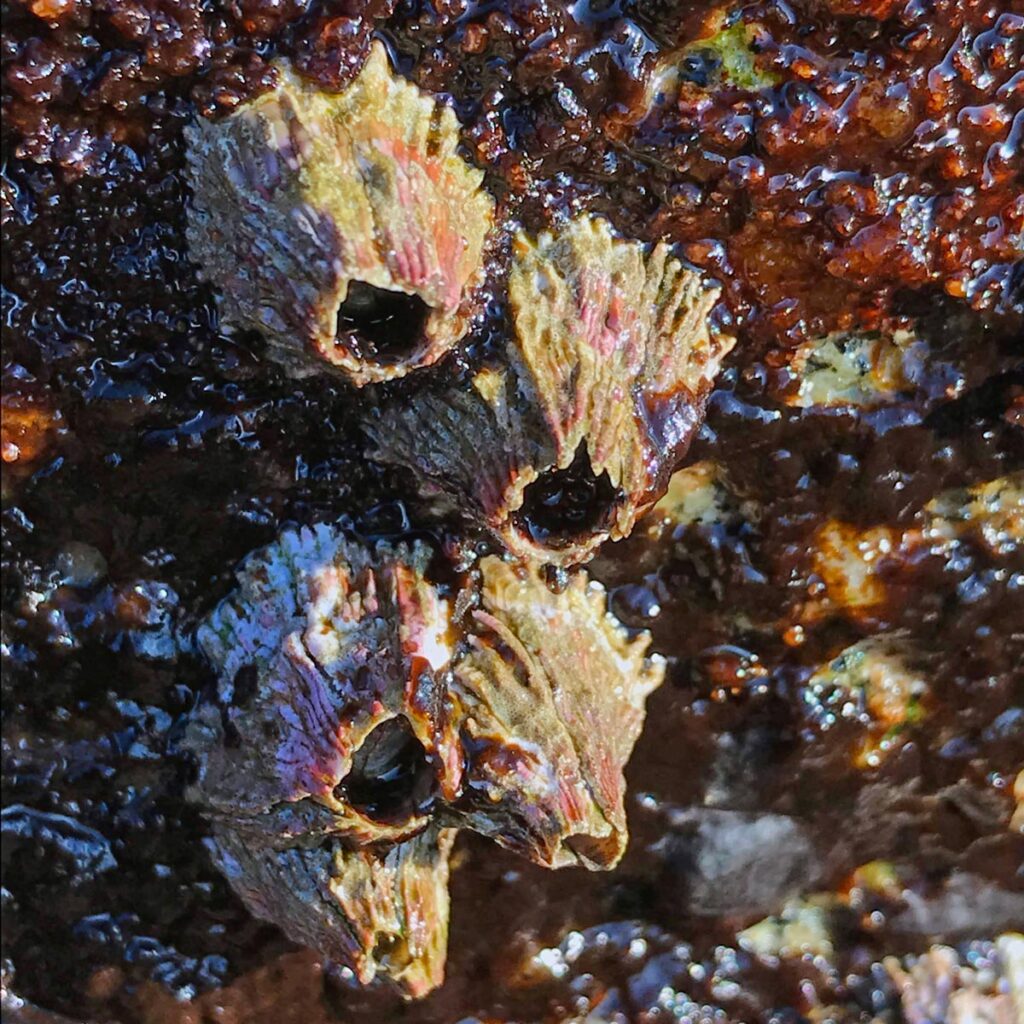
Pink Acorn Barnacle (Tetraclita rubescens)
- Description
Pink acorn barnacles are large (3-5 cm), ribbed, and reddish-pink in color. They are usually found growing as solitary individuals rather than in groups.
- Distribution
- Mendocino County to southern Baja California. This species has expanded its northern range limit by several hundreds of kilometres from San Francisco, CA, USA, since the 1970s.
- Habitat
- Common, but scattered, in mid-low intertidal zones; often found amongst mussels.
- Diet
- Plankton
- Fun Fact
This barnacle is an effective competitor for space in the low intertidal zone, and individuals may grow to a size large enough to exempt them from predation by many gastropods and sea stars. Some individuals may live as long as 10-15 years.
- Reason for Monitoring
These barnacles are a southern species nearing their northern limit in the Monterey Bay National Marine Sanctuary (MBNMS). Their abundance in the MBNMS is expected to increase if global warming continues. This species might be sensitive to sewage pollution.
- References
Dawson, M. N., Groberg, R. K., Stuart, Y. E. and Sanford, E. 2010. Population genetic analysis of a recent range expansion: mechanisms regulating the poleward range limit in the volcano barnacle Tetraclita rubescens. Molecular Ecology 19: 1585–1605. doi: 10.1111/j.1365-294X.2010.04588.x
Littler, M.M. and Murray and S.N. Murray 1975. Impact of sewage on the distribution, abundance, and community structure of rocky intertidal macro-organisms. Marine Biology 30:277-291.
Morris, R.H., D.P. Abbott, and E.C. Haderlie. 1980. Intertidal Invertebrates of California. Stanford University Press, Stanford, California.
UCSC’s Pacific Rocky Intertidal Monitoring: Tetraclita (Pink Barnacle)
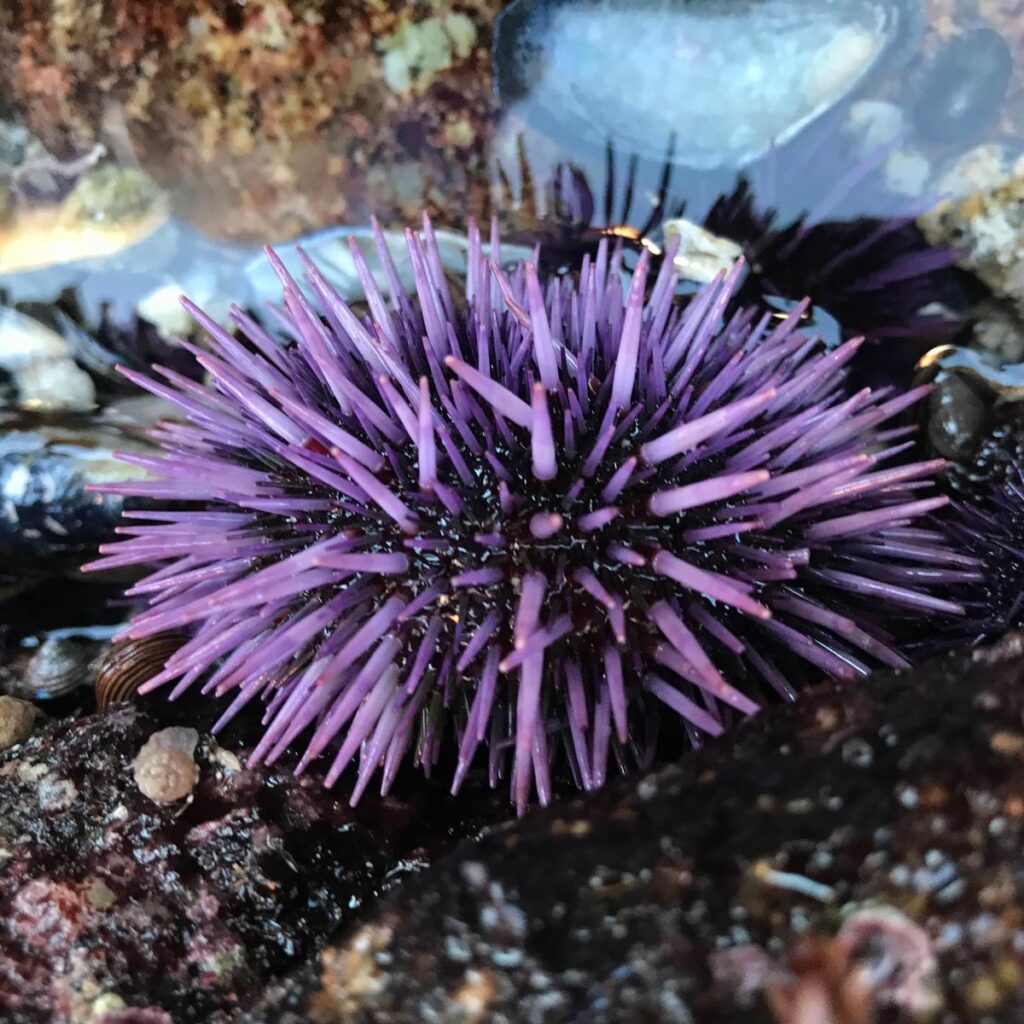
Purple Sea Urchin (Strongylocentrotus purpuratus)
- Description
The body and spines of this echinoderm are typically bright purple; juveniles are green; average body size is 5 cm in diameter; tube feet allow animals to cling to rocks.
- Distribution
- Alaska to Baja California.
- Habitat
- Common in lower intertidal zone and near pilings with strong wave action; commonly inhabit rounded burrows or depressions in rocks formed by the spines and the grinding teeth of the urchin.
- Diet
- A variety of brown and red algae, but they prefer giant kelp.
- Fun Fact
Urchins can regenerate broken spines. This is the first species of sea urchin that has had its complete genome sequenced; it is a model animal for the study of development.
- Reason for Monitoring
This species is harvested for food in California. In 2000, 20 million lbs of sea urchins were harvested, primarily for markets in Japan.
- References
Morris, R.H., D.P. Abbott, and E.C. Haderlie. 1980. Intertidal Invertebrates of California. Stanford University Press, Stanford, California.
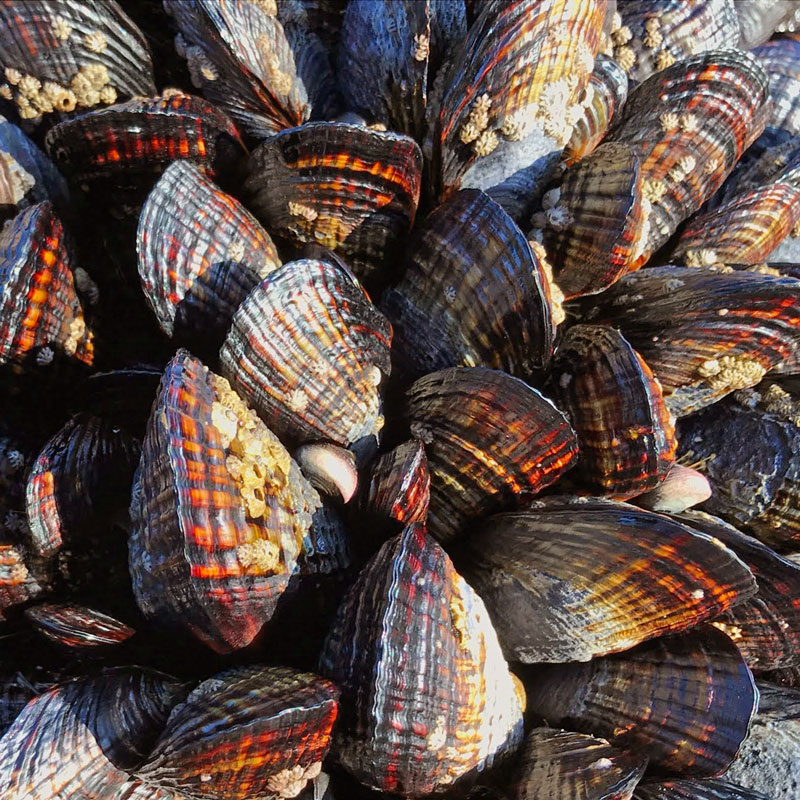
Sea Mussel (Mytilus californianus)
- Description
Bivalve mollusk; shell up to 20 cm in length, black and bluish in color with coarse ribs.
- Distribution
- Aleutian Islands to Baja California.
- Habitat
- Dominant member of mid-intertidal zone; found in surf zone on rocks and wharf pilings.
- Diet
- Plankton
- Fun Fact
Mussels are attached to hard substrate by secreting byssal threads at the base of the foot. Mussel beds provide important refuge and habitat for a variety of invertebrates and algae.
- Reason for Monitoring
Competitive dominant; major space occupier in mid zone. Harvested extensively by humans for food (great steamed and dipped in garlic butter!), but can contain deadly poison.
- References
Morris, R.H., D.P. Abbott, and E.C. Haderlie. 1980. Intertidal Invertebrates of California. Stanford University Press, Stanford, California.
UCSC’s Pacific Rocky Intertidal Monitoring: Mytilus (California mussel)

Sunburst Anemone (Anthopleura sola)
- Description
This anemone is distinguished by the sunburst pattern of radiating lines on oral disk; most are 10-15 cm (4-6 inches) in crown diameter, but can reach up to 25 cm (10 inches) in diameter. Tentacles usually with white blotches, rarely pink-tipped; can be confused with giant green anemones because they are similar in size, but are distinguished by lines on disc and tubercles in rows on column. More difficult to distinguish from aggregating anemone as main difference is mode of growth: clonal versus solitary; recent genetic studies revealed that the two are separate species that do not interbreed.
- Distribution
- Northern central California to central Baja California.
- Habitat
- Often abundant on rocks surrounded by sand, mainly in lower mid zone extending well into the subtidal.
- Diet
- Prey mainly on small crustaceans and other animals in the plankton, but also take dislodged mussels and other intertidal animals. Also possess symbiotic algae within their tissues that provide supplimental nourishment and oxygen.
- Fun Fact
Closely related to the aggregating anemone, this species was given its own name only recently. Up until then it was known as a form of aggregating anemone that lived in the low intertidal in southern California and did not clone, remaining solitary. There is another solitary sea anemone that looks similar, the giant green anemone, that lives intertidally in the cooler waters of central and northern California but it lacks the conspicuous radiating lines on the oral disk.
- Reason for Monitoring
This is a southern species near its northern limit in central California. Their abundance in central and northern California is expected to increase if global warming continues. Major space competitor and predator.
- References
Biological Sciences: Santa Barbara City College
Morris, R.H., D.P. Abbott, and E.C. Haderlie. 1980. Intertidal Invertebrates of California. Stanford University Press, Stanford, California.
Pearse V. and Francis L. 2000. Anthopleura sola, new species, solitary sibling species to the aggregating sea anemone, A. elegantissima (Cnidaria: Anthozoa: Actiniaria: Actiniidae). Proc Biol Soc Washington 113: 596-608.

Turban Snails (Chlorostoma brunnea/funebralis)
- Description
Shell is round, shaped like a turban, not pointed at the apex; can be dark purple, black, orange, or brown in color; usually up to 3 cm in diameter; often aggregates in groups.
- Distribution
- C. brunnea range is from Oregon to Santa Barbara (Channel Islands). C. funebralis range is from Vancouver Island to Central Baja California.
- Habitat
- Turban snails are some of the best known snails along the coast; black turbans are very abundant in tidepools and on rocks in the high and mid tide zone of the rocky intertidal. Brown turbans (C. brunnea) are common in low intertidal zone and shallow subtidal rocky shores.
- Diet
- Herbivore that eats microscopic films and macroscopic algae.
- Fun Fact
Turban snails are preyed upon by sea otters, rock crabs and the ochre sea star; also collected by humans for food.
- Reason for Monitoring
These are major grazers of algae in the intertidal. They are also harvested by people for food.
- References
Morris, R.H., D.P. Abbott, and E.C. Haderlie. 1980. Intertidal Invertebrates of California. Stanford University Press, Stanford, California.

Whelks (Acanthinucella spp./Nucella spp./others)
- Description
Whelks are a group of predatory snails. The shells can be lots of different colors; black, grey, orange, purple with stripes, gray with stripes; up to about 4 cm in length. Note that both ends of whelk shells are pointed.
- Distribution
- Varies with species.
- Habitat
- High and middle intertidal zones mostly; on rocks experiencing some wave action; unicorn snails (Acanthinucella spp.) and dogwinkles (Nucella spp.) are often found in mussel beds and among barnacles.
- Diet
- Feeds primarily on mussels, barnacles, limpets and herbivorous snails such as turban snails and periwinkles; holes are drilled in the shells of prey by means of the radula and an accessory boring organ located on the sole of the foot which softens the shell.
- Fun Fact
Unicorn snails and dogwinkles spawn sporadically throughout the year in California most actively from November to March. Females deposit their eggs in yellow vase shaped capsules (as many as 300 capsules per cluster with average of 500 eggs per capsule).
- Reason for Monitoring
These are major predators in the intertidal.
- References
Morris, R.H., D.P. Abbott, and E.C. Haderlie. 1980. Intertidal Invertebrates of California. Stanford University Press, Stanford, California.
We also monitor:
- Bare rock
- Loose sand
- Tar (petroleum)

